(Jim Cooke / Los Angeles Times)
25 shady L.A.-area spots to beat the heat right now
- Share via
Trees can solve so many problems.
On the hottest of summer days, their evergreen canopies cool our homes and streets and shelter us from ultraviolet rays.
Anyone who has gotten lost in the intricate details of an ancient African Cape chestnut tree in Elysian Park or the thick bark of a coast live oak in La Cañada Flintridge knows they are magical too.
Here are several of our favorite places to find shade in the L.A. area, including parks and public gardens.
Dog parks, coffee shops, desert raves, breakfast meetups, community centers and hiking groups are keys to making friends in Los Angeles.
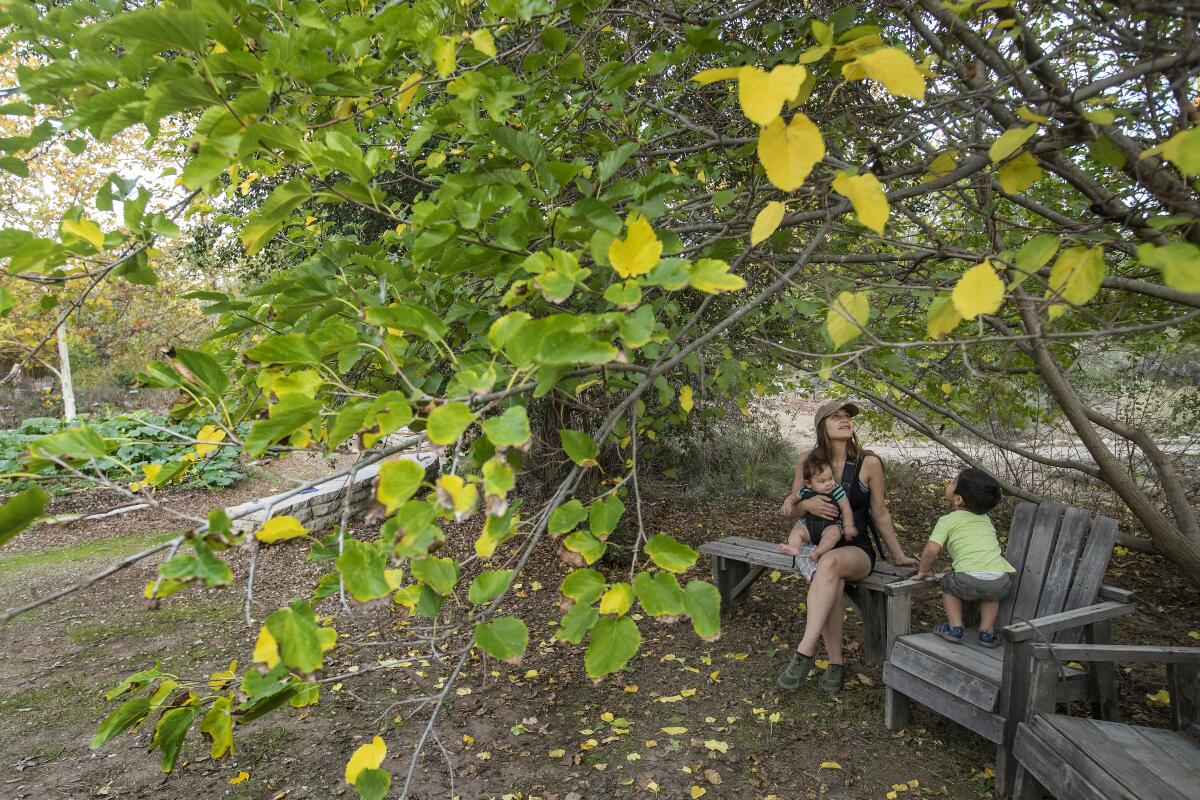
Arlington Garden
This is a garden where you can bring a book or a picnic, let children safely run free or find a sheltered corner for coffee and intense conversation. During a visit late on a fall Friday afternoon, one young woman sat in a corner of the allée with her sketch pad; a slender walker gaped at the white barrel-shaped blooms oozing with bees on a tall San Pedro cactus (Echinopsis pachanoi); and a toddler wheeled and shrieked with excitement at finding a pumpkin in the vegetable patch. Use this garden as you would a pair of comfortable shoes — as often as you can, with gratitude and love.
Admission is free and it’s open daily from sunrise to sunset. Dogs are permitted if leashed.
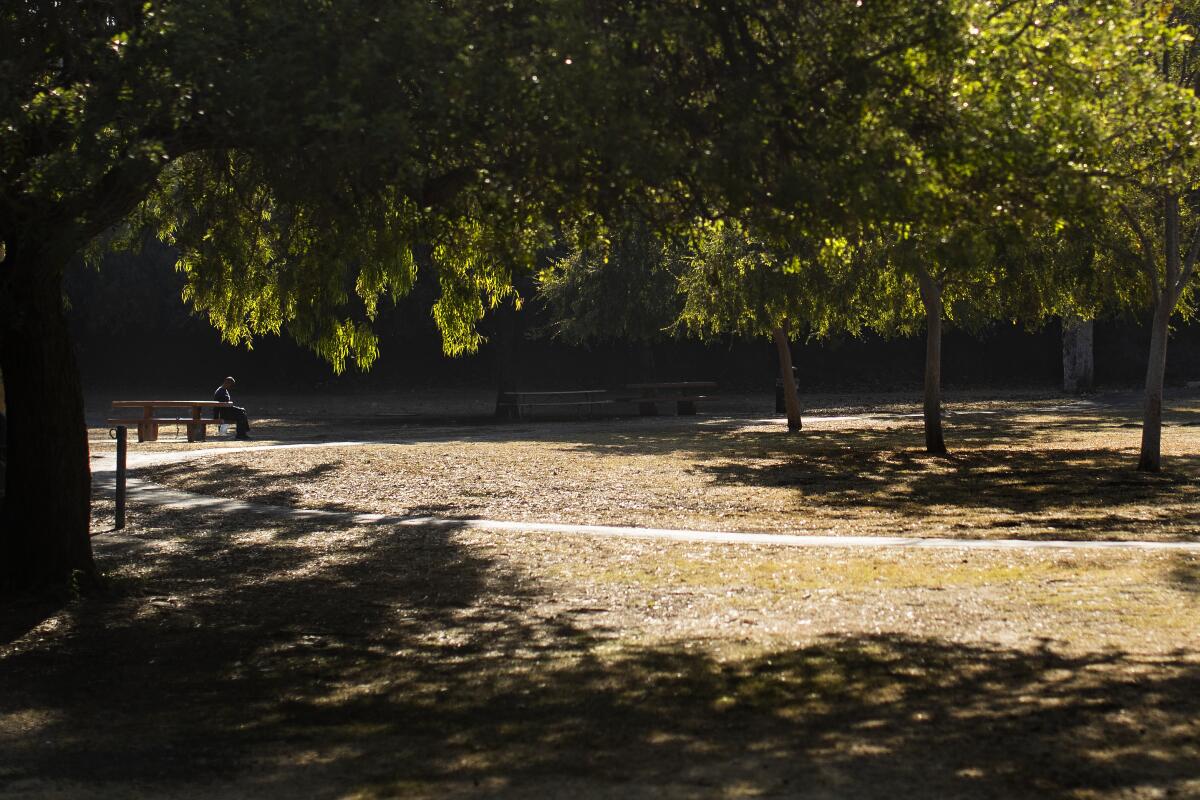
Audubon Center at Debs Park
Admission: Free
Hours: Open daily from 8 a.m. to 4 p.m. Closed Tuesdays.
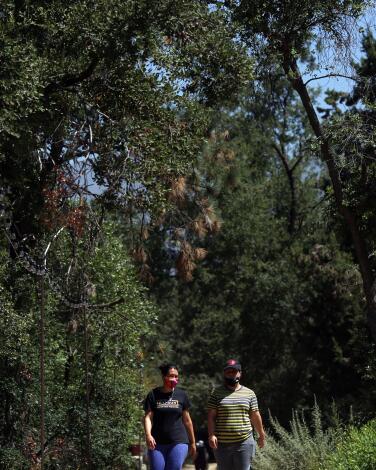
California Botanic Garden
This is a lovely garden to learn how native plants look when they’re mature. The garden’s website lists what’s currently in bloom, and from October to May, you can purchase many of the plants you admire in the on-site Grow Native Nursery. Note: This is a great place to appreciate the heady fragrance of many California native plants. A slight stroke of a branch can fill the air with scent. Just be gentle when you walk by.
Admission: $10, $6 seniors and students, $4 ages 3-12, and free entry for members and children under 3. Annual memberships start at $50 for individuals and $85 for families.
Hours: Open 8 a.m. to 8 p.m. Tuesday to Sunday.
Food is not permitted in the gardens. No pets permitted except trained service dogs.
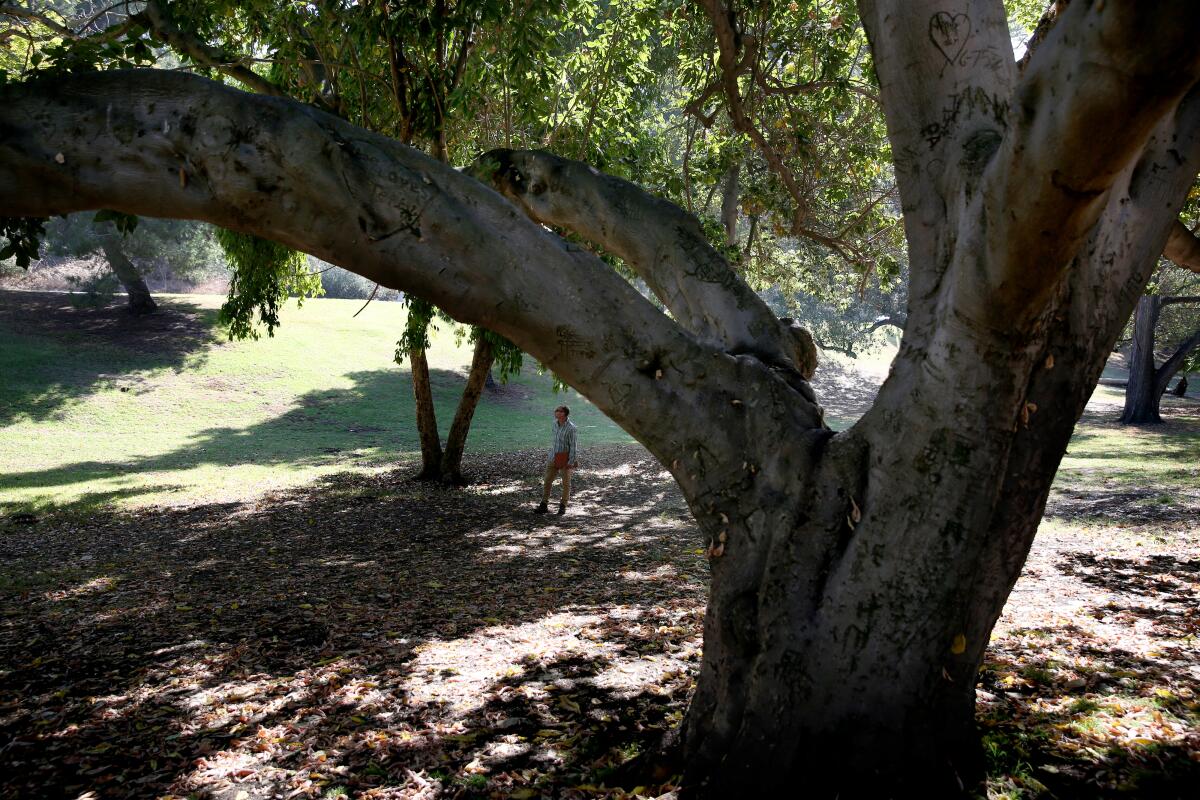
Chavez Ravine Arboretum
Wander the park and take in the many rare specimens: floss silk trees (Chorisia speciosa) from South America, noted for their pink flowers and sharp conical prickles on their trunks; the Dombeya wallichii trees, native to Madagascar, located near the Grace E. Simons Lodge and known for smelling like cake frosting when in bloom; the tallest Queensland kauri (Agathis robusta) in the continental U.S. at 120 feet high; the first Cape chestnut (Calodendron capense) and a bald cypress (Taxodium distichum var. nutans).
During the pandemic, the arboretum became popular with yoga instructors who held class in the shade of the park’s magnificent trees. In a positive twist to the pandemic, it’s a trend that continues.
Admission: Free
Hours: Sunrise to sunset
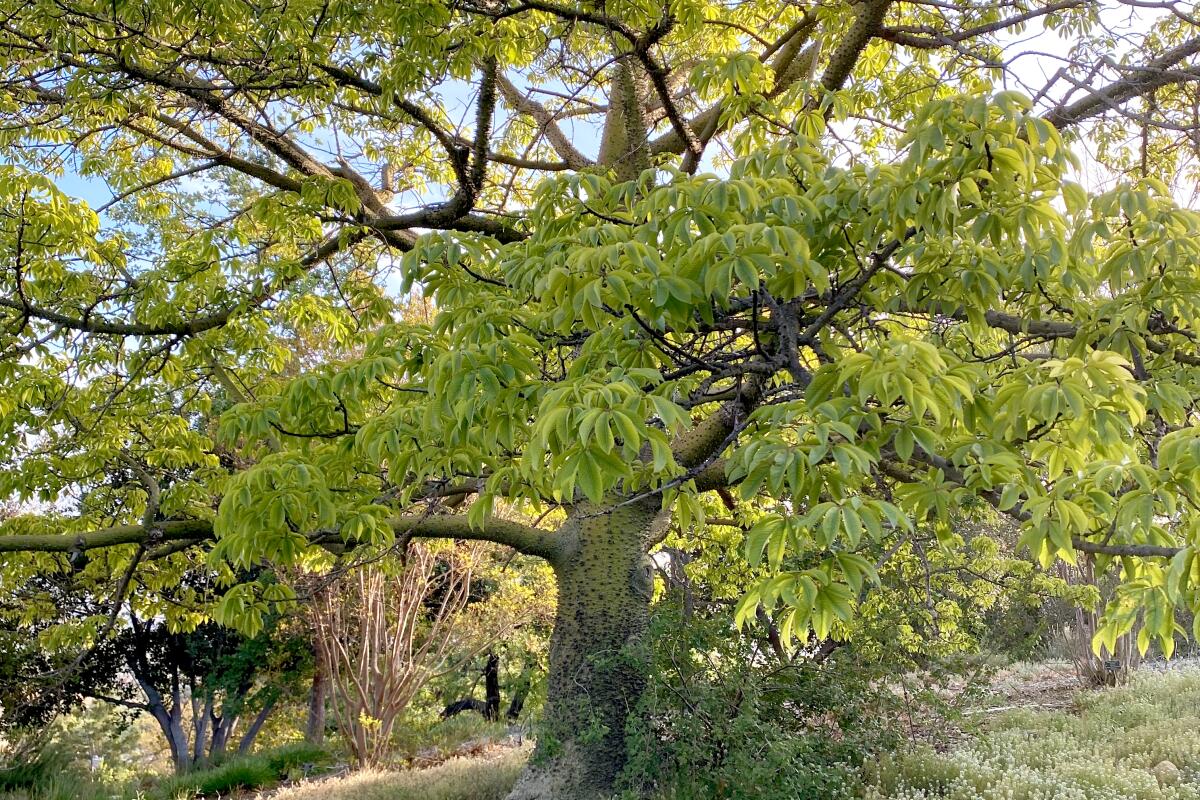
Conejo Valley Botanic Garden
This is a good place to bring children, with a stream running through, bridges here and there, and plenty of plant diversity, from a rare-fruit orchard and oak grove to gardens dedicated to butterflies, a bird habitat, desert cactuses and succulents, herbs, Australian plants, colorful native salvia and a “Trail of Trees” (more than 50 varieties of trees planted in 2005 to replace a slope covered with invasive mustard weed).
There’s also a special garden for children open from 11 a.m. to 3 p.m. on Sundays only. Another impressive fact: This nonprofit botanic garden was started by three local volunteers in 1973 — Ray Garcia, Fred Wilson and Jackson Granholm — after a housing developer donated the hilly, unbuildable 33 acres to the Conejo Recreation and Park District, said botanic garden president Beverly Brune. Today, the gardens comprise 41 acres and are completely managed by volunteers and funded by money raised by grants and fundraisers such as the garden nursery, which sells plants propagated from the garden from 9 to 11 a.m. Wednesdays and from 11 a.m. to 3 p.m. Sundays in the Kids’ Adventure Garden.
Hours: Open daily, sunrise to sunset, except during rain, high winds, on July 4 and when trails are muddy. The Kids’ Adventure Garden is only open 11 a.m. to 3 p.m. Sundays.
Food is not permitted in the gardens. Dogs are permitted if leashed.
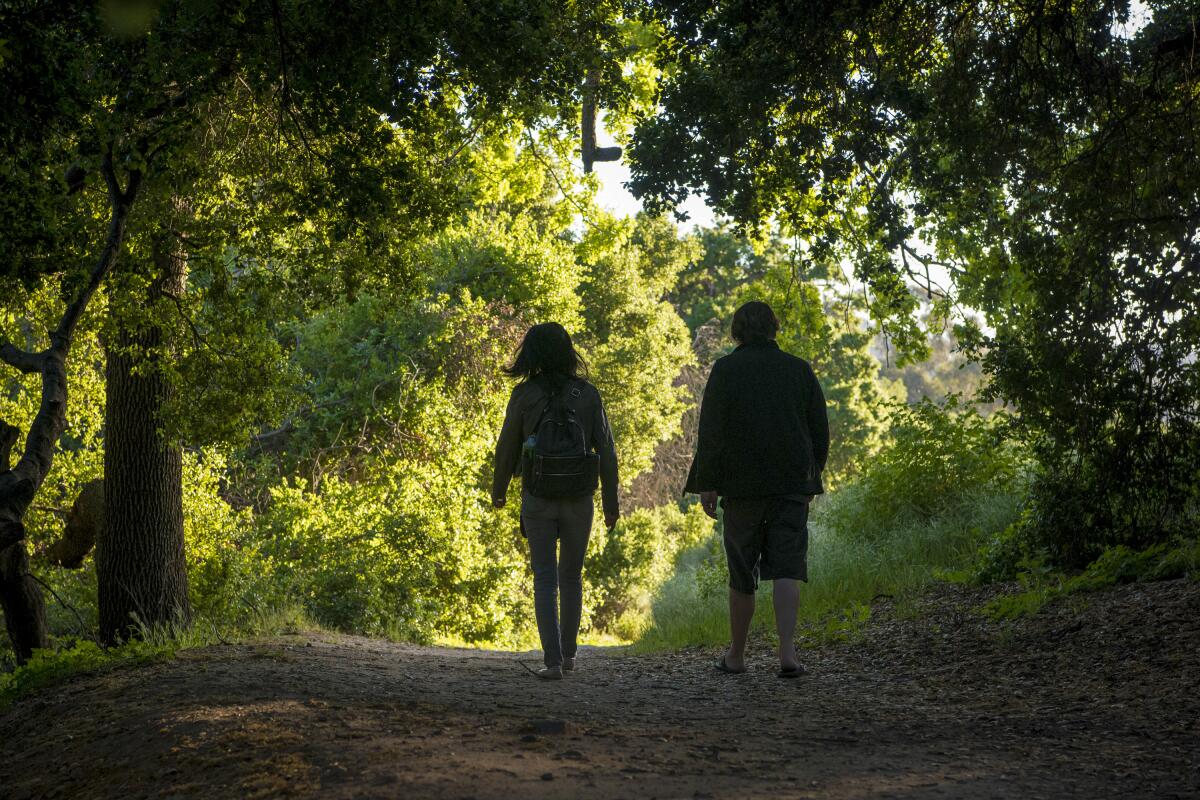
Corriganville Park
Movies that were filmed here include “Fort Apache,” starring John Wayne; “Jungle Jim,” starring Johnny Weissmuller; and “The Three Musketeers,” starring Lana Turner and Gene Kelly. TV shows include “Bonanza” and “The Lone Ranger.”
Today, the interpretive trail includes 20 informative signs that indicate indigenous plants and animals as well as the historical spots where movies and TV shows were filmed, including “Sherwood Forest,” where “Robin Hood” was shot.
Admission: Free
Hours: Open daily from sunrise to sunset.
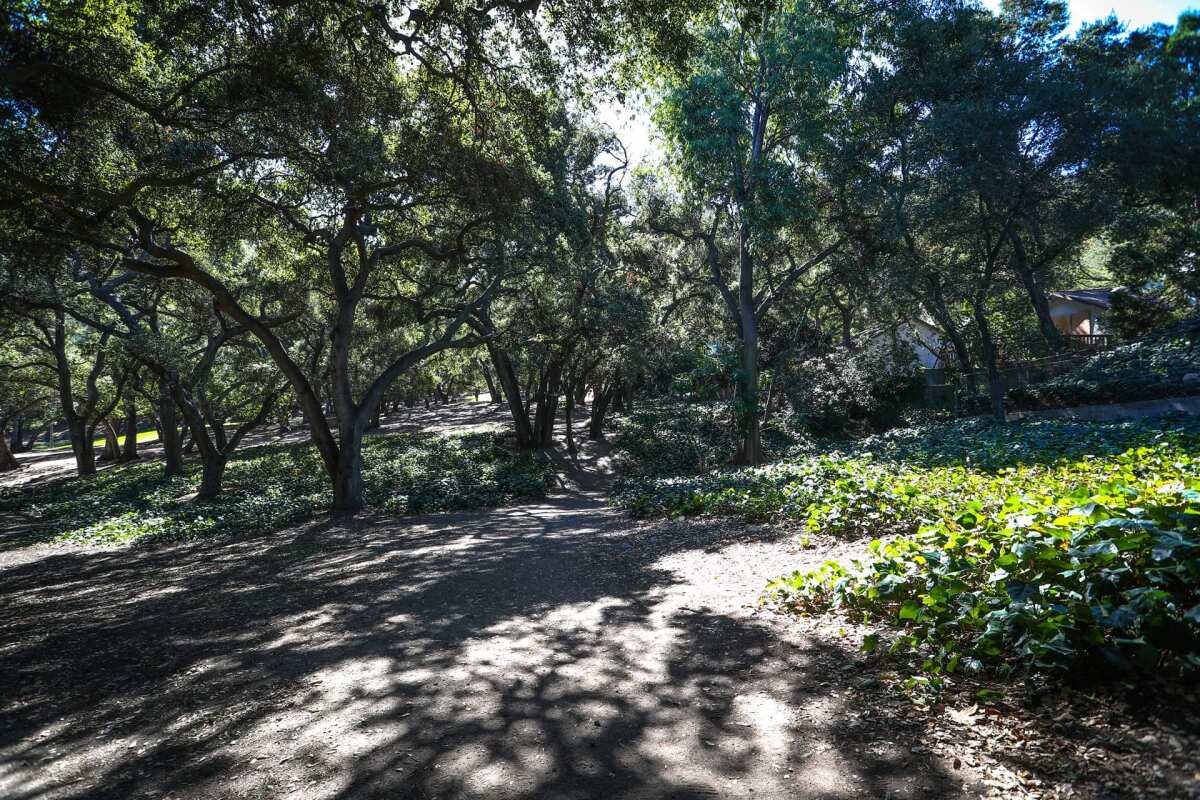
Crescenta Valley Community Regional Park
There is a shaded playground behind the baseball fields off New York Avenue as well as a more-than-10,000-square-foot skate park with shade structures, a dog park and basketball courts. There are plenty of picnic tables as well as group picnic shelters, but the best place to relax is under the shade of one of the park’s many trees.
Hours: 6:30 a.m. to 9 p.m. daily
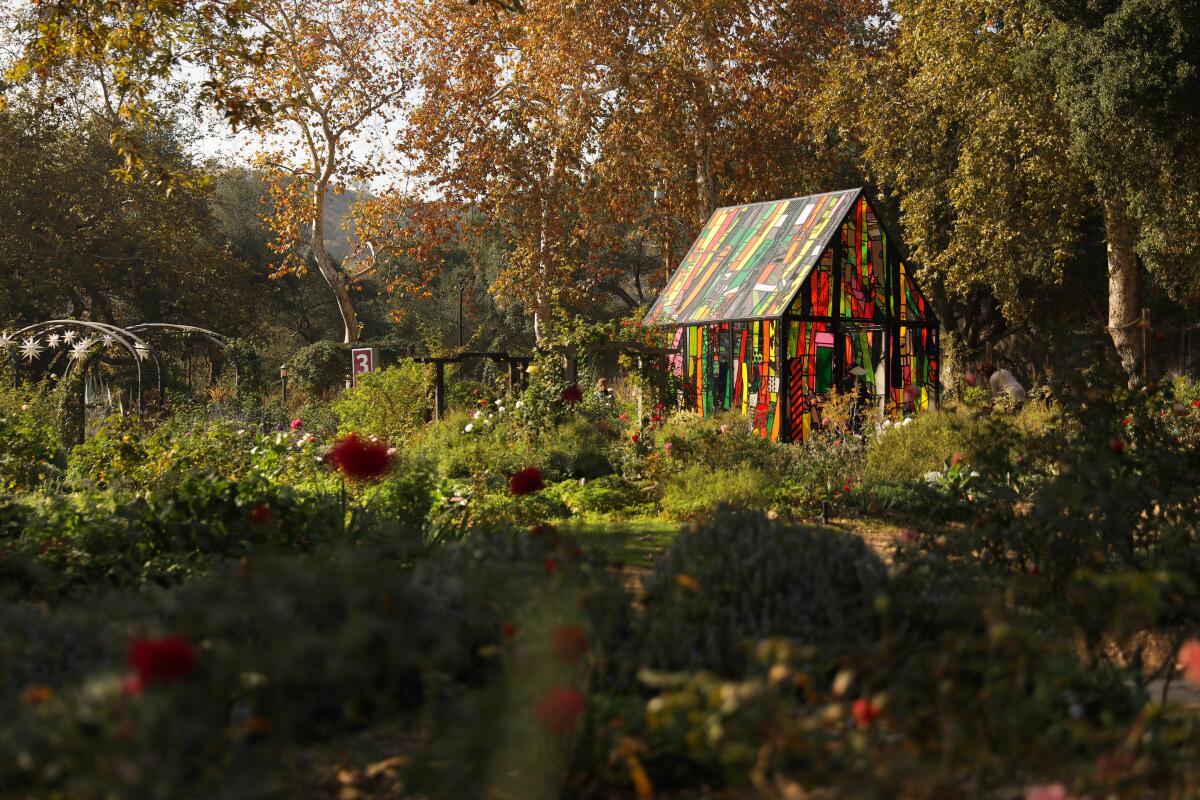
Descanso Gardens
Visit often to check out the changing gardens because there’s always something blooming at Descanso. Whether you’re feeling reflective or joyous, this garden will always be uplifting.
Admission: $15, $11 for seniors 65 and over and students with ID, $5 for children ages 5-12, members and children under 5 enter free. Annual memberships start at $70 for individuals and $99 for families.
Hours: 9 a.m. to 7 p.m. Monday-Friday, 9 a.m. to 5 p.m. Saturday-Sunday during the summer.
Food can be purchased on-site daily at the Kitchen at Descanso from 9 a.m. to 4:30 p.m. During the summer, food can be purchased from 9 a.m. to 6:30 p.m. Monday-Friday and 9 a.m. to 4:30 p.m. Saturday-Sunday.
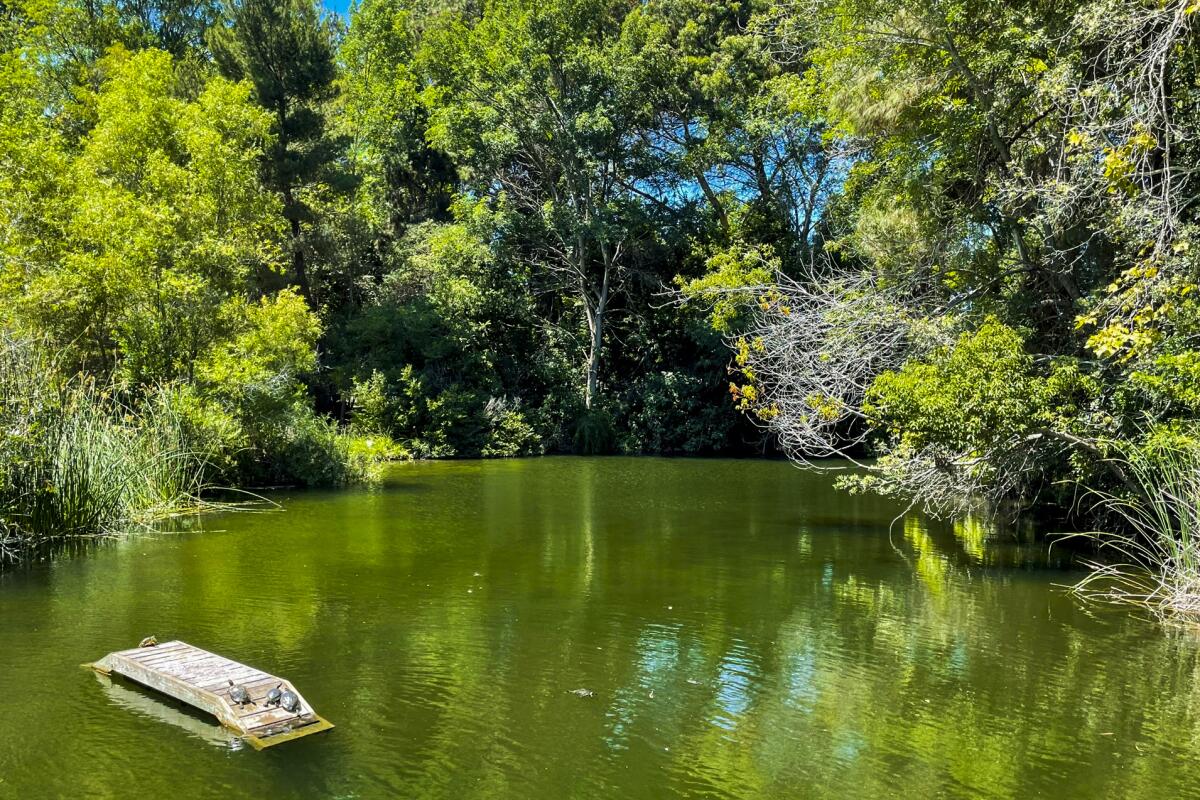
El Dorado Nature Center
The nature center features many California native plant varieties, including oaks, redwoods and a white alder grove. It also has an art gallery and gift shop on a small island in one of the lakes. The park is popular with bird watchers who flock to the park to see the more than 150 resident and migratory bird species that have been spotted here.
After a hike, explore surrounding El Dorado East Regional Park, which has a dog park, more lakes and shaded places to seek out on a hot day.
Hours for trails: Open 8 a.m. to 5 p.m. Tuesdays through Sundays. No trail entry after 4:30 p.m.
Admission: Parking is limited and costs $6 and up, cash only. Pedestrians and cyclists enter free.
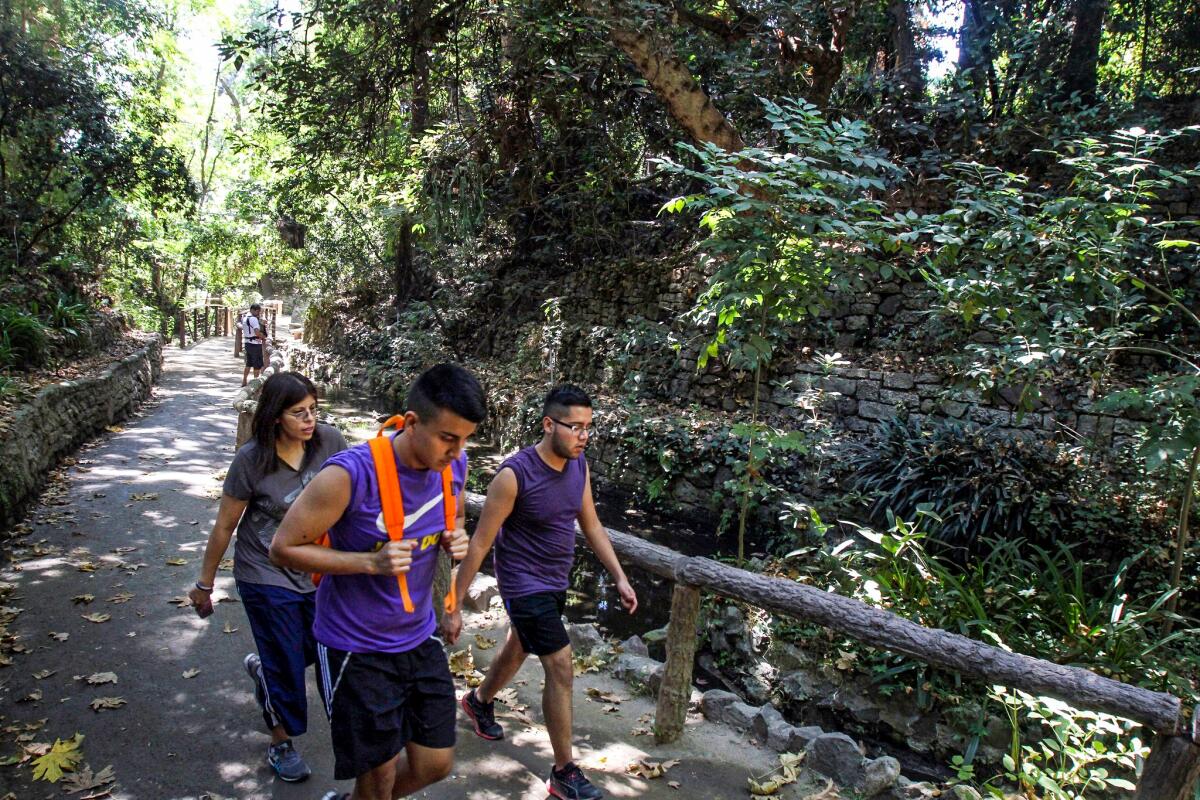
Fern Dell
More than 50 fern species, including some that are California natives, thrive along the shady trail located near the Western Canyon entrance off Los Feliz Boulevard. Non-native varieties include ferns from Africa, South America, Australia and Southeast Asia.
If you’re up for a hike, the paved walkway becomes a dirt path that will take you to Griffith Park Observatory and the Mt. Hollywood peak, which is about a 5-mile loop. Afterward, enjoy coffee and a snack in the shade at Trails Cafe, which is open from 8 a.m. to 2 p.m.; closed Tuesdays and Wednesdays.
Hours: 5 a.m. to 10:30 p.m. daily

Fullerton Arboretum
Don’t miss the spectacular rock fig with its pale green trunks rising ghostlike from the heavily leaf-littered ground. At the east side of the garden is the thorn forest with truly bizarre plants such as the silk floss tree, with its thorn-studded branches and trunk and delicate lilylike blooms. Suddenly, after all the forests, you are smack in the desert, studded with barrel cactuses, towering agave blooms and also some shade from massive Chilean mesquite trees. The rare-fruit orchard and citrus groves remind us we live in Southern California, and if you’re lucky, you can purchase some of the bounty at the gate, such as bags of fresh fuyu persimmons, sapotes, star fruit and pomegranates.
Admission: $5 suggested donation. Members enter free (annual memberships start at $59 for individuals and $99 for couples).
Hours: 9 a.m. to 4 p.m. Wednesday-Monday; Tuesdays open only to members and Cal State Fullerton students.
Food: No food permitted inside the garden or available for purchase. However, a variety of fruit from the Arboretum’s orchards is periodically for sale at the main entrance. No pets permitted except trained service dogs.
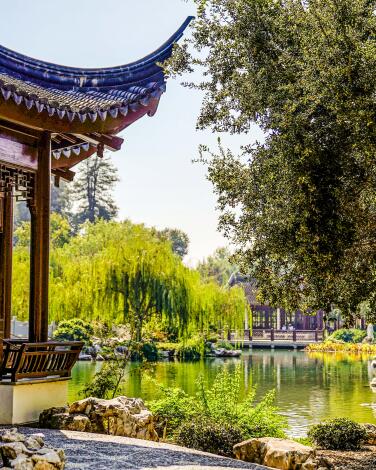
The Huntington Library, Art Museum, and Botanical Gardens
If you go, plan a day devoted to just wandering the Huntington’s 130-acre gardens, a sprawling collection of extraordinary roses, authentic Chinese and Japanese gardens, and areas dedicated to Australian plants, Shakespearean plants, herbs, desert plants, jungle and subtropical plants (you can almost hear Tarzan bellowing somewhere in those towering, vine-dripping trees) and, of course, a whimsical garden to enchant children. The food options are varied and very good.
If you want a free-day ticket (the first Thursday of every month), you’ll need to be strategic, ready to jump on a reservation at 9 a.m. the Thursday before. Due to the huge demand, people are assigned a random number after they enter the online waiting room for free tickets. If your number is selected, you can receive up to five tickets per household (babies also need tickets on free days).
Hours: Hours are 10 a.m. to 5 p.m. Wednesday-Monday, closed Tuesdays. Reservations required for weekend visits.
Admission: Prices start at $25 weekdays and $29 on weekends; slightly lower fees for seniors, students and children. Members and children under 4 enter free. Free days — the first Thursday of every month — require advance reservations made the week prior, and spots fill up quickly. Members are not permitted on free days. Annual memberships start at $159; you can apply up to $50 of your admission fees toward a membership within 24 hours of your visit.
Food is available at several on-site cafes. No pets permitted except trained service dogs.
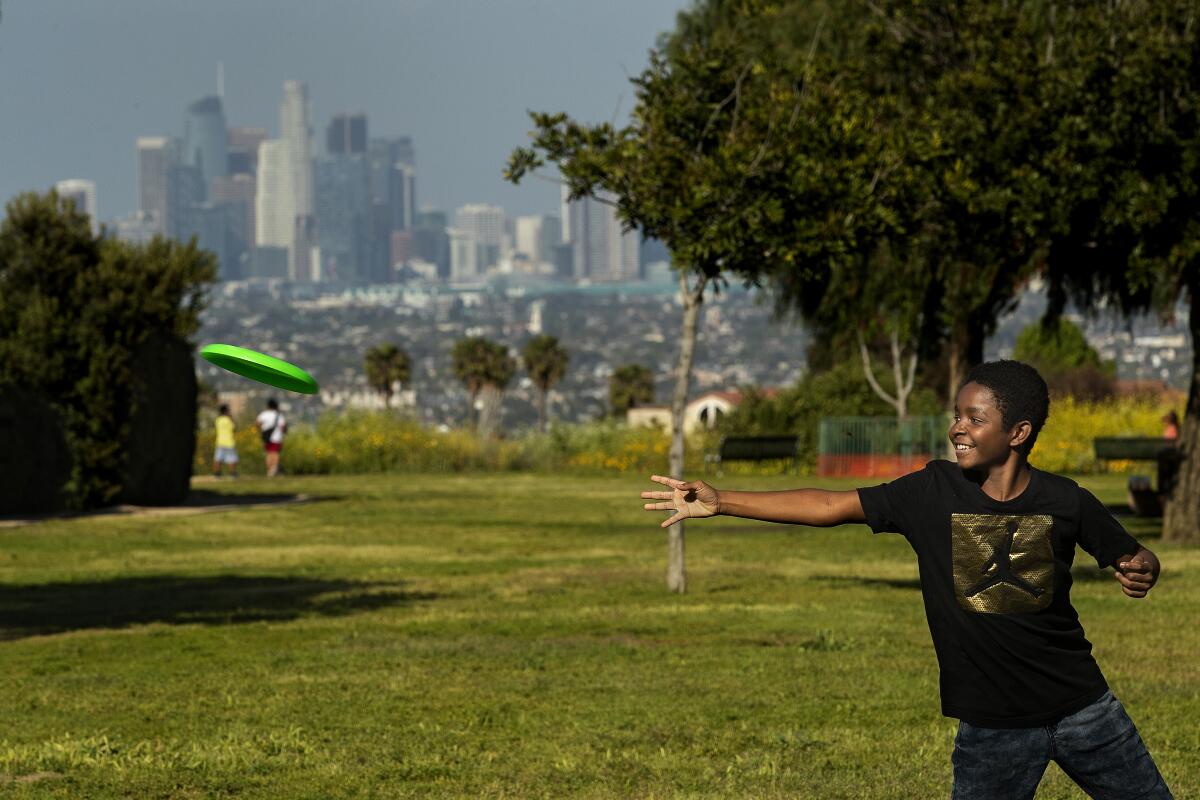
Kenneth Hahn State Recreation Area
In addition to stunning city views of Los Angeles, the park houses a lotus-filled pond, a rushing stream, a grove of low-growing California pepper trees and a Japanese garden.
On Sundays, WalkGood L.A. offers a one-hour, donation-based BreatheGood Vinyasa yoga flow class at 9:45 a.m. in the park. Bring a yoga mat, water and towel.
Hours: 6 a.m. to 8 p.m. daily
Parking: $7 cash
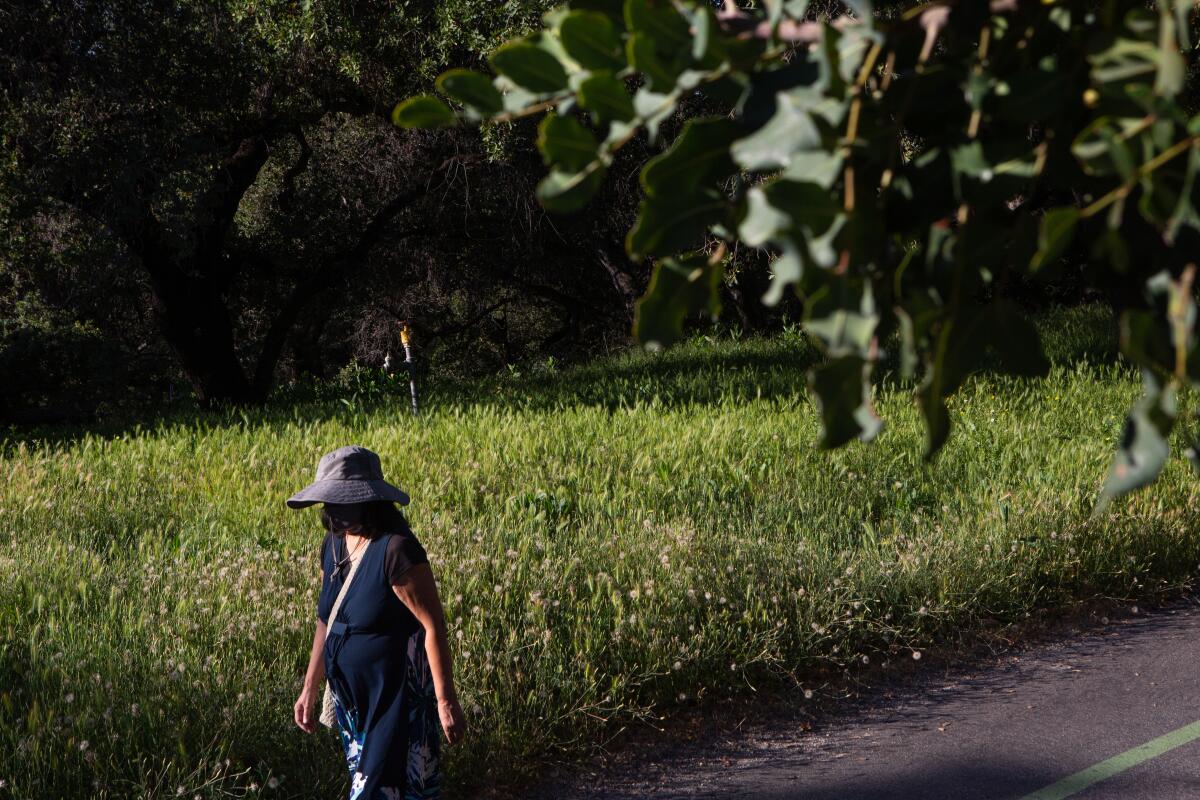
Los Angeles County Arboretum & Botanic Garden
The tropical rainforest is a shady paradise filled with tall cypress trees, cycads, a grove of bamboo and tropical trees from around the world.
Keep an eye out for bird watchers as you tour the Arboretum — the garden serves as a sanctuary for many species of resident, migratory and visiting birds and includes more than 250 species.
Admission: $15, $11 seniors and students, $5 ages 5-12, members and children 4 and younger are free. Annual memberships are $70 for individuals, $65 for two seniors (age 62+) and $95 for families. Free day the third Tuesday of the month with advance reservations, which are available the first of each month.
Hours: Summer hours are 9 a.m. to 7 p.m. (last entry at 6:30 p.m.) Monday-Friday and 9 a.m. to 5 p.m. (last entry at 4:30 p.m.) Saturday-Sunday. Early entry for members at 7:30 a.m.
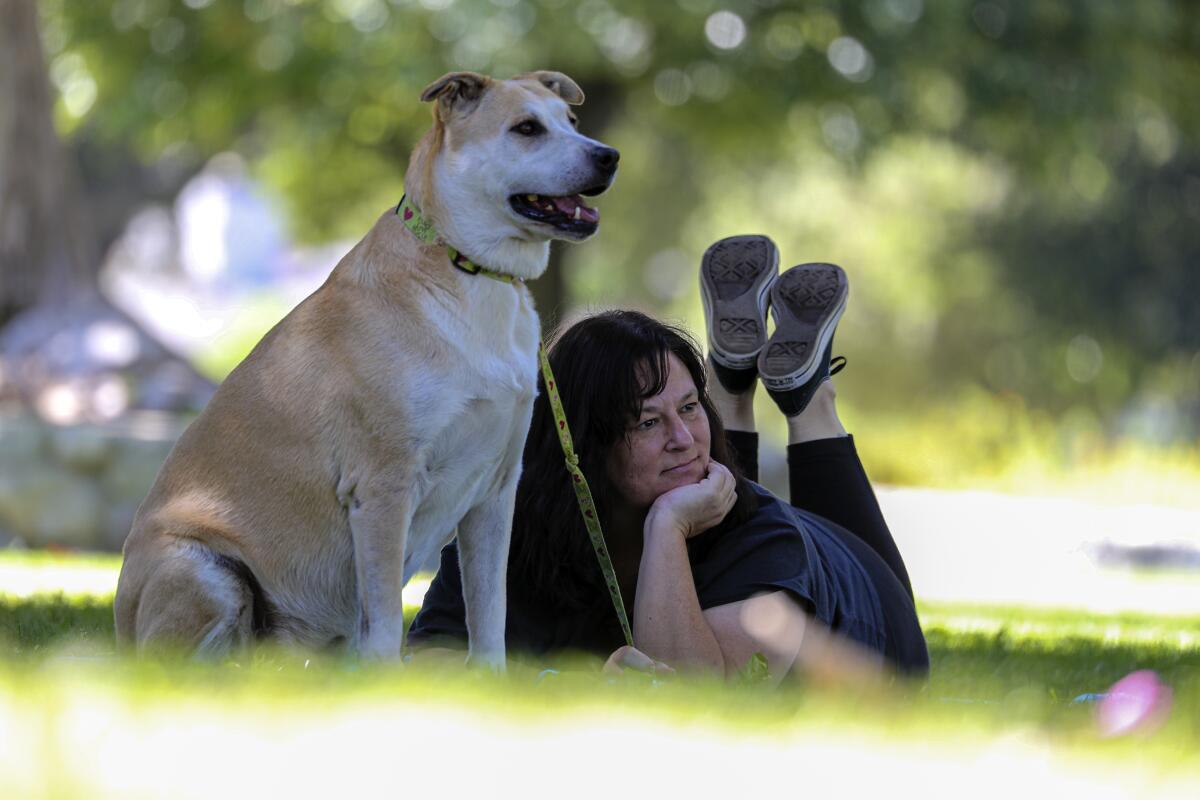
Memorial Park
The park is also home to the historic Garner House, and in the summer, the city of Claremont hosts Monday night Concerts in the Park in the bandshell.
Hours: Open from 6 a.m. to 10 p.m.
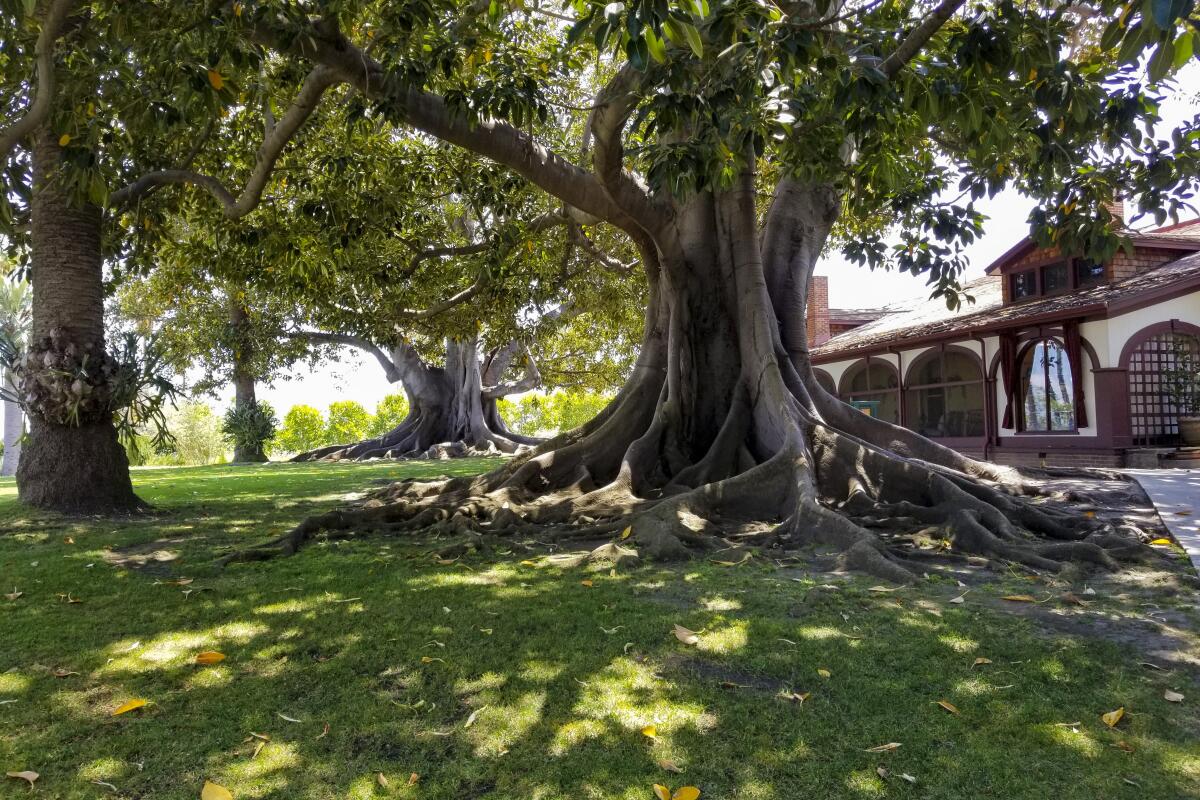
Rancho Los Alamitos
Hours: Open 1 to 5 p.m. Wednesdays through Sundays
Admission: Free
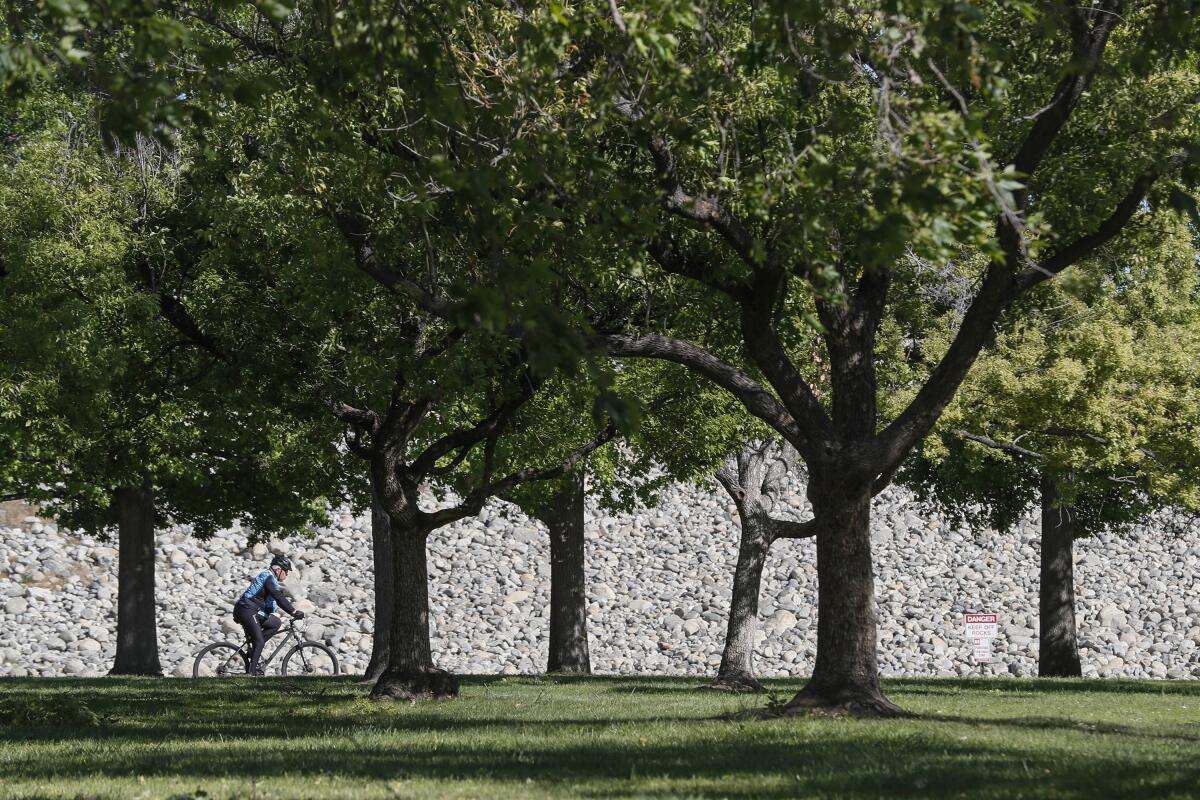
Santa Fe Dam Recreational Area
The park includes a nature center, native plant garden, a waterless plant experimental garden, a Native American gathering circle, nature trails and picnic areas.
Hours: Open daily from 6 a.m. to 8 p.m. March 1 to Oct. 31; the Nature Center is open from 10 a.m. to noon on Saturdays.
Admission: Free. Vehicle entry fee $12.
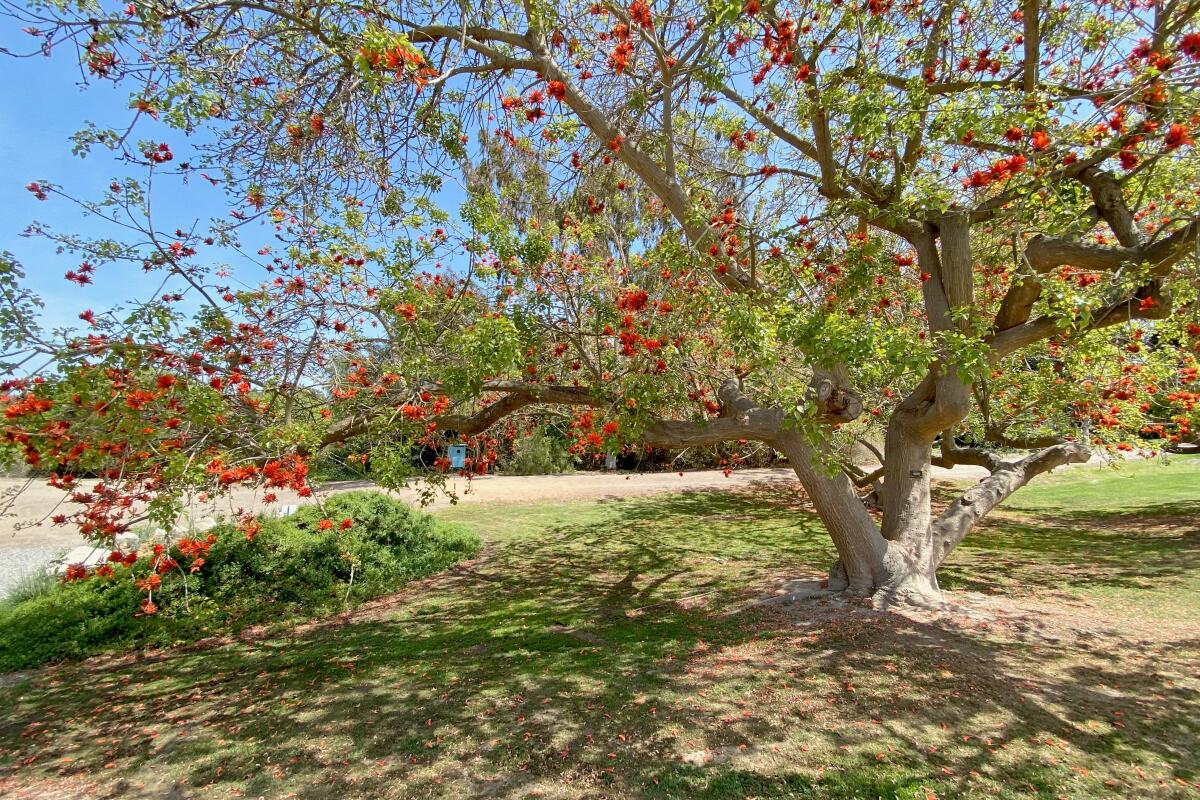
South Coast Botanic Garden
All in all, the garden has more than 2,500 different species of plants and five miles of trails, but if that feels overwhelming, the garden’s website offers a downloadable map for easy planning, along with suggestions for what to see based on how much time you have to visit.
The garden also has two popular seasonal events that require an additional fee: SOAR, its butterfly pavilion and garden that is currently focused on monarch butterflies, and GLOW (Garden Lights & Ocean Waters), its winter light show. If you have only 45 minutes, you can see a lot at this garden, but if you’ve got the time, it’s an easy, fragrant place to while away an entire afternoon. Just remember to bring something to eat.
Hours: Open 8 a.m. to 5 p.m. daily except Dec. 25.
Admission: Reserved tickets required; $15, $11 seniors 62+ and students, $5 children ages 5-12, free for members and children 4 and younger. (Members need to reserve tickets only on weekends.) Free admission with reservations on the third Tuesday of each month. Annual membership is $45 for individuals and $65 for two adults and up to four children under 18.
Food isn’t available for purchase. Carry-in food is permitted. No pets permitted except trained service dogs. Dogs are permitted if leashed only on designated dog-walking days about 10 times a year.
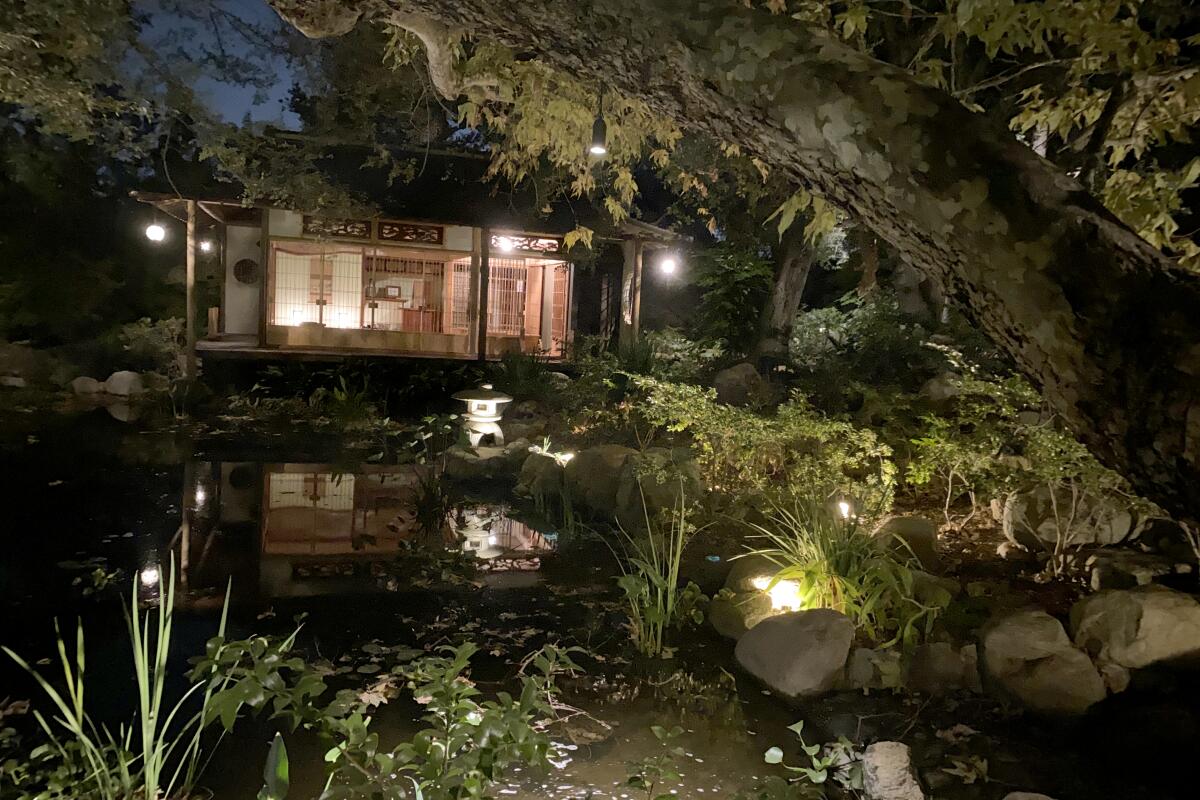
Storrier Stearns Japanese Gardens
If you’re looking for a special evening out, grab your favorite takeout and a bottle of wine and watch the day melt into night, with strings of lights reflecting off the koi pond. (Bring your own cups, bottle openers, cutlery and plates to the garden, and take it all with you when you leave.) The teahouse is lighted and open for visitors day or night. Just remember to remove your shoes.
Admission: Tickets are $12 if purchased online and $15 if purchased at the gate (and if space is available); children 12 and under enter for free.
Hours: Open 4 to 8 p.m. Fridays and Saturdays and 10 a.m. to 4 p.m. Sundays.
Food not available for purchase. Carry-in food is permitted. Dogs are not permitted in the garden.
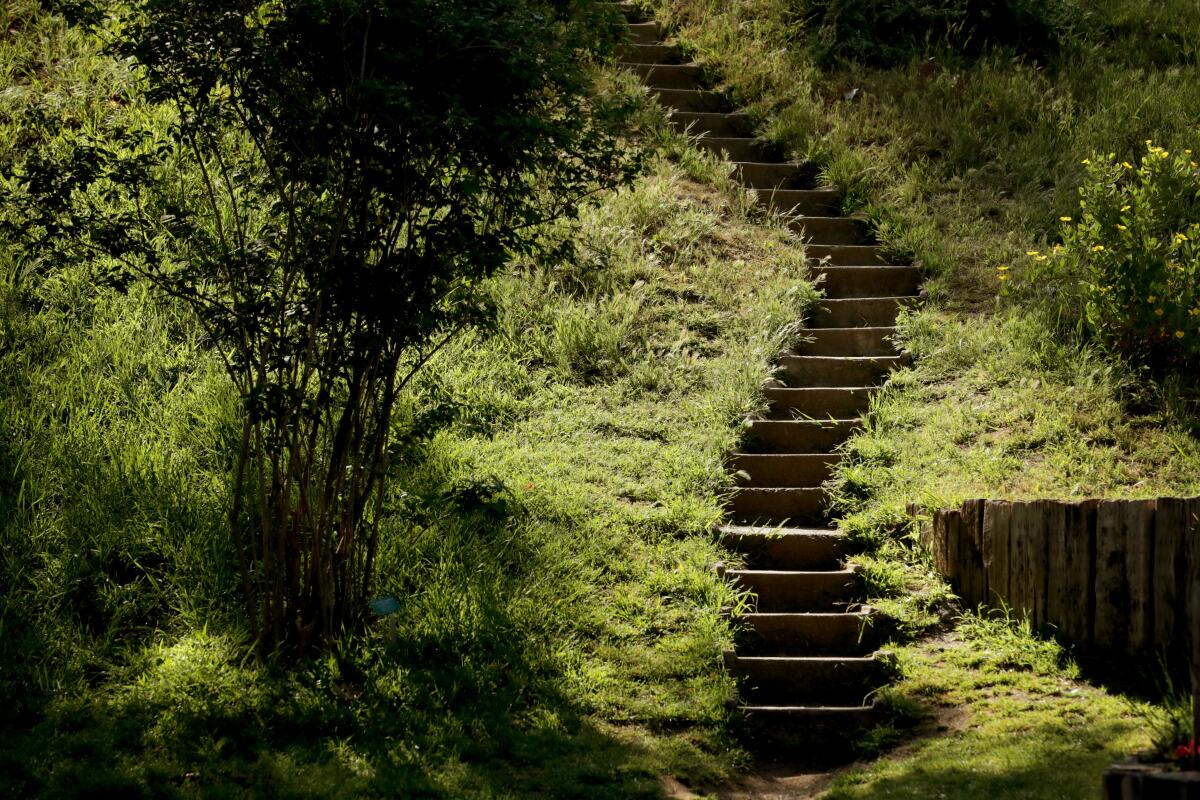
UC Riverside Botanic Gardens
The garden also has collections from a variety of geographical areas, including Australia and South Africa, as well as the eastern United States, with its temperate deciduous forests and North American deserts. And, of course, it also covers regions of California, from Baja and the California chaparral to North Coast redwood forests, oak woodlands, coastal sage scrub — native to the hills where the gardens are located — and a lovely shady area known as Alder Canyon full of native California riparian trees.
Admission: No charge but suggested $5 donation.
Hours: Open Sunday-Friday during the summer from 8 a.m. to 2 p.m. Master Gardener docents are available in the butterfly garden the first and third Sunday of every month through October from 9 a.m. to noon to answer questions about gardening for butterflies. The campus calendar is here.
Food not available for purchase. Pets are not permitted in the garden.
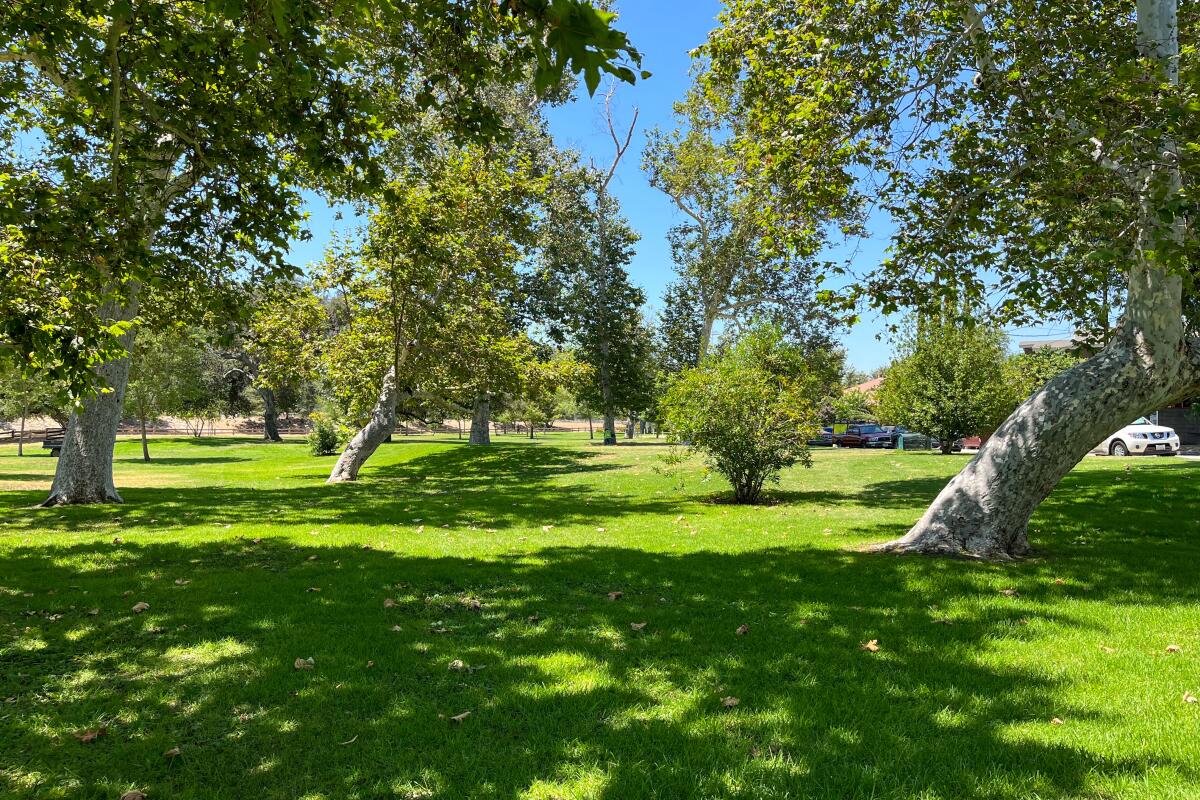
Bette Davis Picnic Area
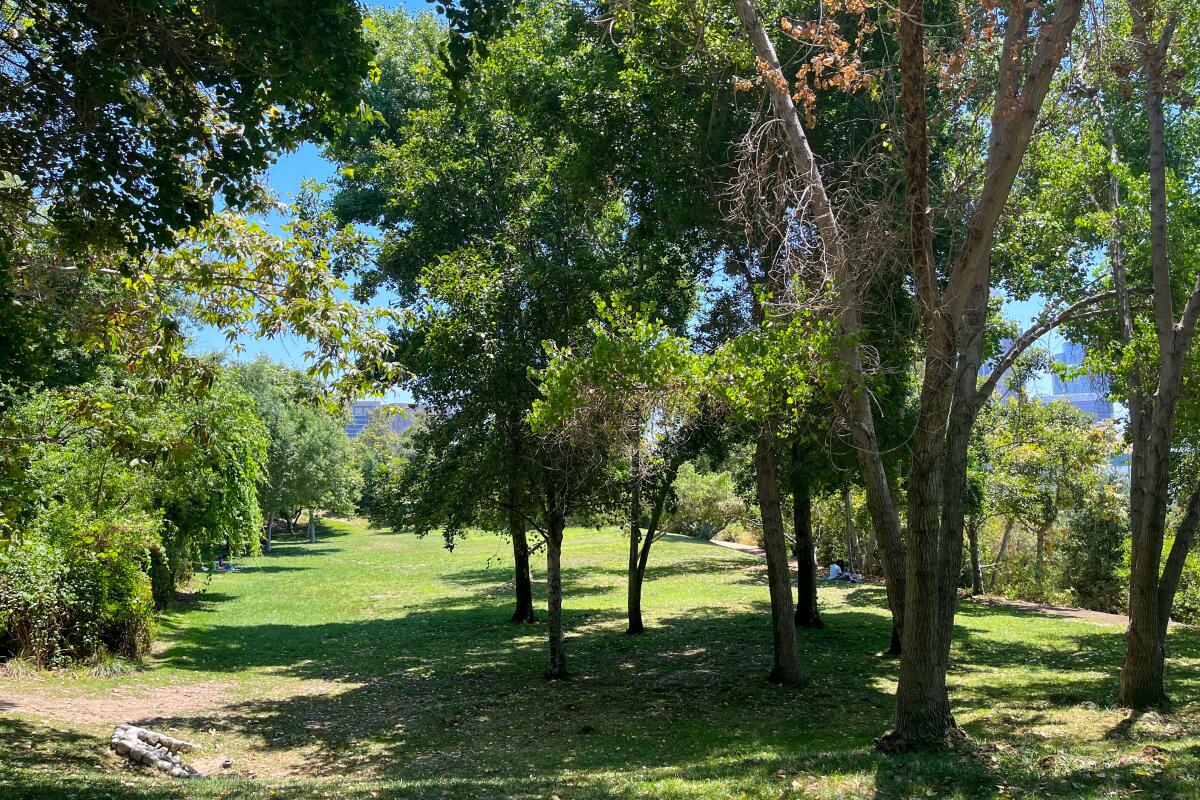
Vista Hermosa Natural Park
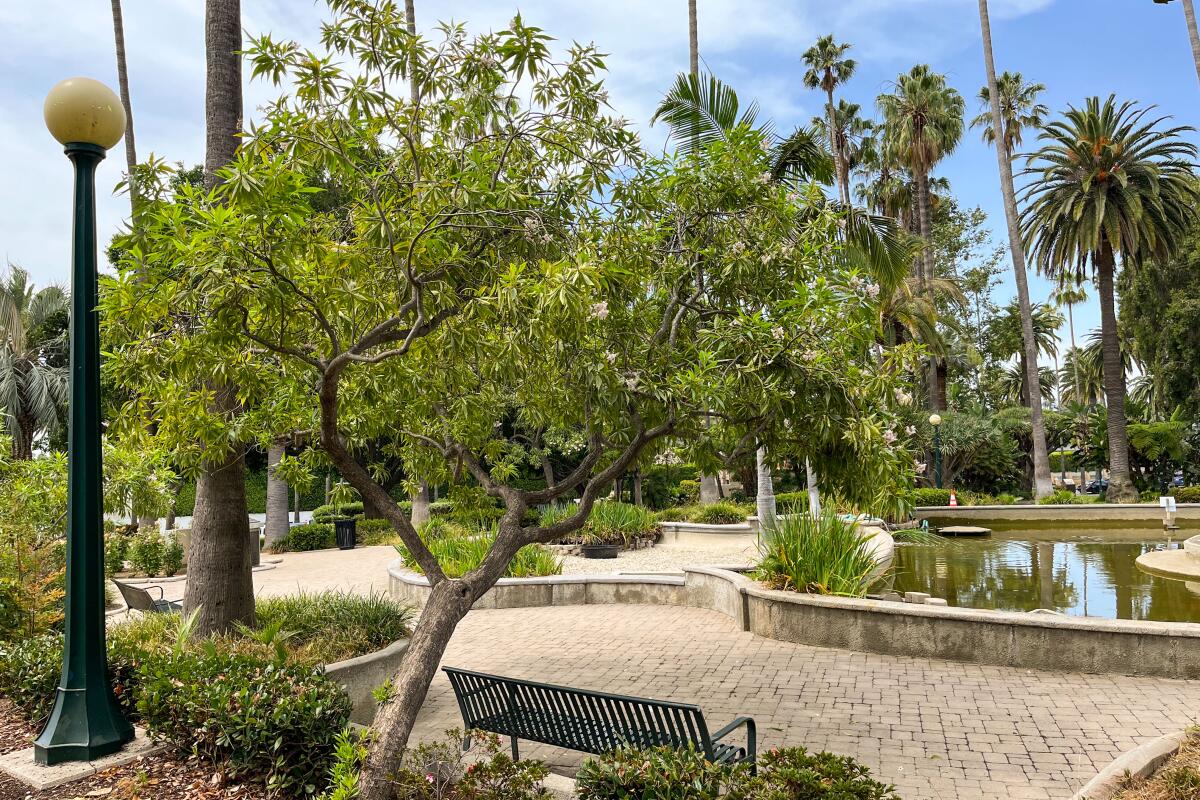
Will Rogers Memorial Park
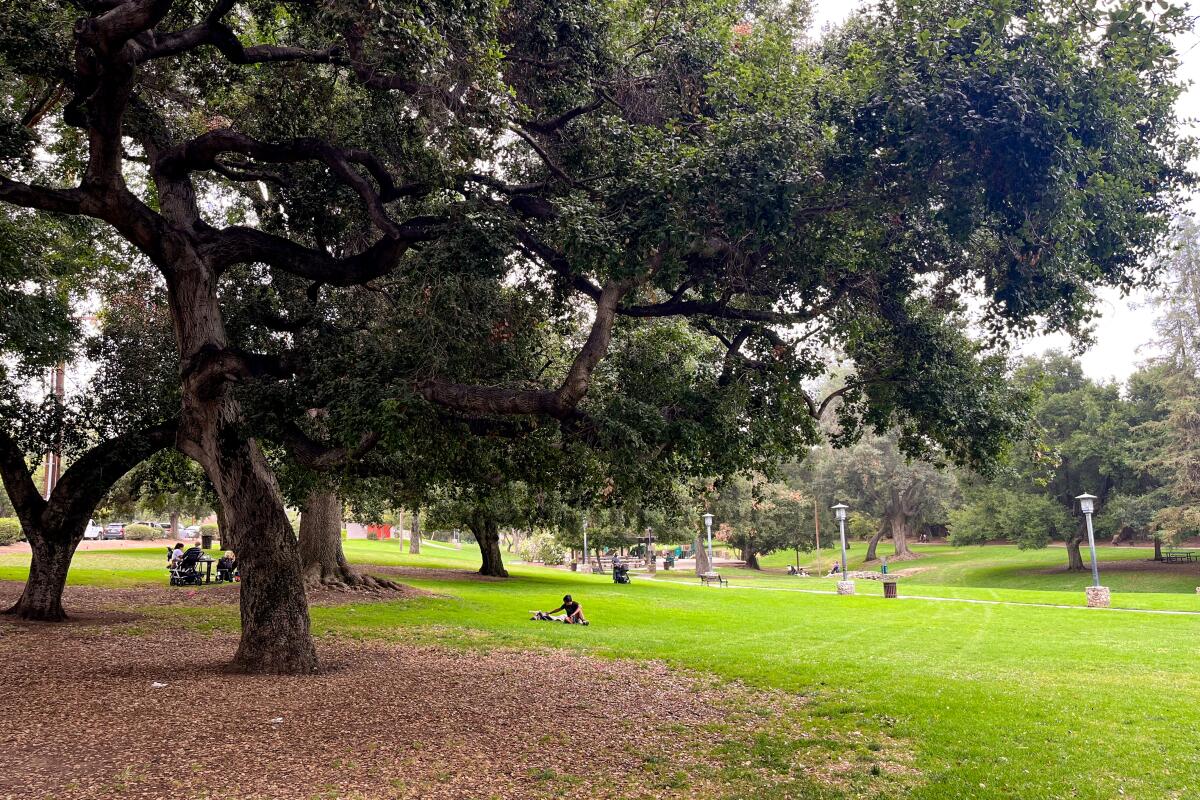
Garfield Park
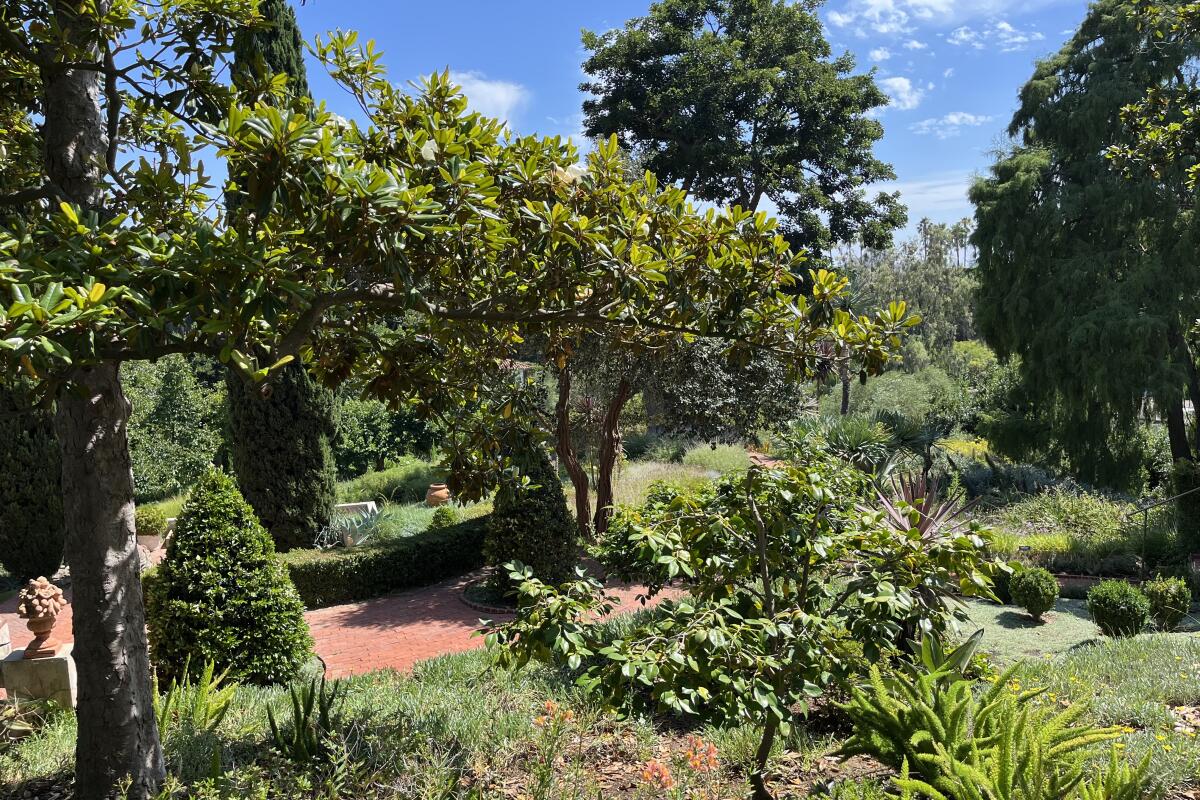
Virginia Robinson Gardens
Sign up for This Evening's Big Stories
Catch up on the day with the 7 biggest L.A. Times stories in your inbox every weekday evening.
You may occasionally receive promotional content from the Los Angeles Times.








